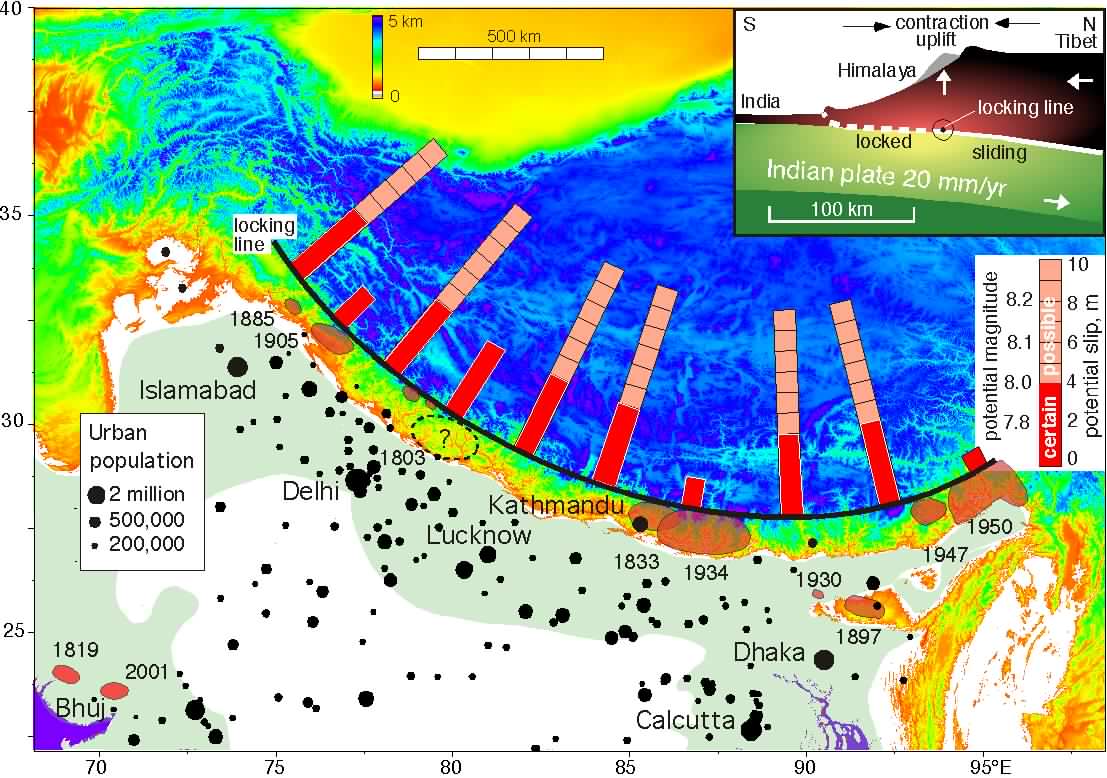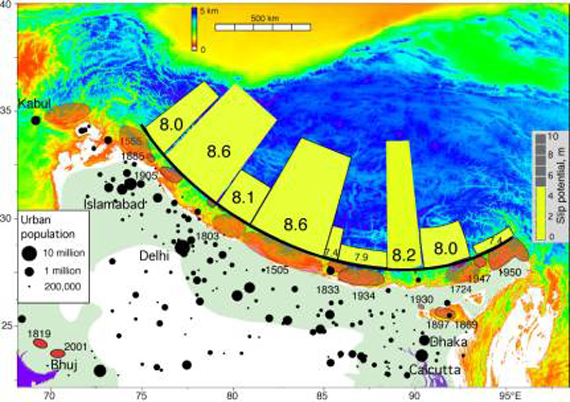It looks like you're using an Ad Blocker.
Please white-list or disable AboveTopSecret.com in your ad-blocking tool.
Thank you.
Some features of ATS will be disabled while you continue to use an ad-blocker.
5
share:
Kathmandu is one of the most vulnerable cities in the world, also experienced rapid urban development ..
The population has increased from 427,045 in 1991 to 671,805 in 2001 and is projected to touch a figure of 915,071 in 2011 and 975,453 in 2012 ..
Construction of buildings considered too weak to withstand a powerful quake, similar to Haiti catastrophic earthquake of M 7.0 what kill more of 316,000 people ..


www.scidev.net...
www.channelnewsasia.com...
The population has increased from 427,045 in 1991 to 671,805 in 2001 and is projected to touch a figure of 915,071 in 2011 and 975,453 in 2012 ..
Construction of buildings considered too weak to withstand a powerful quake, similar to Haiti catastrophic earthquake of M 7.0 what kill more of 316,000 people ..


Images of the Main Himalayan Thrust (MHT) fault showed that a segment of it dips downwards by 15 degrees, and is steeper and further north than suggested by previous observations. This dip could rupture and cause an earthquake of magnitude 8 or more, often referred to as a mega earthquake.
The researchers predict that the segment will break over a larger area of the fault and create a larger magnitude earthquake than previously thought.
"The larger the area of the fault that breaks, the more energy is released, and the larger the magnitude of the earthquake,"
The study, presented at the American Geophysical Union Fall Meeting in San Francisco earlier this month (7 December), measured ground movements. By placing seismometers closer together in one area, the researchers have been able to produce a more detailed image of the MHT. Klemperer says a big earthquake would start at the top of the sloping segment. "This is in central Nepal — where Kathmandu is — but such a big earthquake would devastate a much larger area." "This would cause huge landslides, some of which would dam rivers, and produce large lakes. There would be catastrophic floods," he says.
www.scidev.net...
"The main area of concern is in central and west Nepal, where there has not been a large earthquake for a long period," Petley told AFP after Sunday's 6.9-magnitude quake damaged hundreds of homes in the east of the country. "This is an earthquake-prone area, so this suggests that there is a large amount of energy stored," he said.
Nepal is a highly seismic region, lying above the collision of the Indian and Eurasian plates that created the Himalayas, and major earthquakes have hit the Kathmandu Valley every 75 years on average over recent centuries.
One quake destroyed a quarter of homes in Kathmandu 77 years ago, and geologists believe the area is at immediate risk of an 8.0-magnitude tremor - ten times the size of last year's Haiti quake which killed more than 225,000 people.
"The building stock is not seismically strengthened, suggesting that in a big earthquake there will be large numbers of building collapses," said Petley, of the Institute of Hazard, Risk and Resilience at Britain's Durham University.
GeoHazards International, a US-based research group, has measured the likely death toll from a quake of 6.0 magnitude or higher hitting cities in Asia and the Americas.
Kathmandu topped the list of 21 cities with 69,000 potential deaths, ahead of Istanbul and New Delhi.
www.channelnewsasia.com...
edit on 17-1-2013 by MariaLida because: (no reason given)
Us to aid seismically resilient modern blood bank
2013-01-16 7:04 PM
www.thehimalayantimes.com...
The United States is helping reduce disaster risks in one of the earth’s most disaster-prone corners, increasing the Nepalese Government’s resilience and strengthening its capacity to respond to its citizens.
transition.usaid.gov...
2013-01-16 7:04 PM
www.thehimalayantimes.com...
KATHMANDU: A modern blood bank with seismically resilient technology is to be established at the premises of the Tribhuvan University Teaching Hospital (TUTH), Maharajgunj.
The Government of the United States of America (USA) is going to provide the support for the establishment of the blood bank.
Minister for Health and population, Rajendra Mahato, and U.S. Ambassador to Nepal, Peter W. Bodde jointly laid the foundation stone of the building of the blood bank here today.
The total cost of the building has been estimated at Rs. 50 million. Construction of the building, which will resist an earthquake of 9 Richter Scale, will be completed within one year in partnership of U.S. government and TUTH.
According to the U.S. Embassy, the US Army Corps of engineers with local contractors will provide design, construction management and quality assurance services.
Nepal, among other countries that are most vulnerable to a catastrophic earthquake, is at high risk zone. The Kathmandu Valley with its dense population is particularly vulnerable.
The United States is helping reduce disaster risks in one of the earth’s most disaster-prone corners, increasing the Nepalese Government’s resilience and strengthening its capacity to respond to its citizens.
Perched atop the Himalayas, Nepal faces multiple natural hazards, including annual floods, landslides, and avalanches, as well as periodic droughts, forest fires and disease epidemics. However, for the 28 million people of Nepal, the risk of earthquakes is what looms largest, in particular, the proverbial “big one”—an earthquake impacting urban areas that would eclipse those of recent memory.
Nepal’s capital city of Kathmandu, with an estimated population between 3 million and 5 million, has not experienced a major earthquake in more than 75 years, and there is concern among seismologists that the city could be struck by an earthquake of magnitude 8.0 or greater—at least 10 times as powerful as the January 2010 earthquake that devastated Haiti.
Similar to Haiti, Nepal is situated in a seismic zone that is capable of generating catastrophic earthquakes, and like Port-au-Prince, Kathmandu has experienced rapid urban development, including widespread construction of buildings considered too weak to withstand a powerful quake.
transition.usaid.gov...
edit on 17-1-2013 by MariaLida because: (no reason given)
Discourse on Seismotectonics of Nepal Himalaya and Vicinity:Appraisal to Earthquake Hazard
article.sapub.org...
Abstract
article.sapub.org...
Abstract
An extremely complex geotectonic framework coupled with high seismic status has made the Central part of the Himalayas, a destination to study the complex inter-continental collision processes. The collision also caused large scale deformation and high seismicity of vast region of colliding continents. This region displays all major tectonic features of the Himalayan mobile belt and is seismically one of the active regions in the Himalayan arc. Focal mechanism solutions bear out a multifaceted pattern. Thrust environment is dominant in the Western and Central Nepal region, whereas, in the Eastern Nepal, it is a amalgamation of thrust and strike-slip with large thrust mechanism. In western region thrust faulting coupled with shallow dip nodal planes reflects the Indian lithosphere is under-thrusting at a shallow angle. Here, the crustal shortening in north- south direction in which earthquakes is generated due to northward compression. The shortening was accommodated by development of various NW-SE trending structures like Himalayan Arc MCT (Main Central Thrust), MBT (Main Boundary Thrust); MFT (Main Frontal Thrust). The observed change in the faulting pattern in the eastern parts of the thrust zone may indicate substantial movement along the transverse faults, as compared to that of the western region with the changes in the deep crustal structure. The thrusting decreases rapidly with increasing focal depth and deformation occur due to strike-slip motion at greater depths. This may investigative of an unstable state of the upper mantle leading to a rapid deformation in the presence of high degree of thermal regime. The composite stereographic projection of the compression and tension axes suggest a shallow compressive stress, dipping N-S to NE-SW in Western Nepal whereas it is N-S to NNE-SSW direction of compression at a shallow angle in Eastern Nepal. The region produced a number of devastating events in the past. Central Himalaya comprising Nepal and its adjoining region in which different types of faulting patterns exist have signatures of a great earthquake in 1934 and a number of large events thereafter, advocate serious seismic hazard in the region.
edit on 17-1-2013 by MariaLida because: (no reason given)
Latest EQ's in this area, 2012-2013 ..
2013-01-09 07:44:19.0 29.82 N 81.77 E 30 5.1 NEPAL
2013-01-02 17:42:18.0 29.55 N 81.19 E 10 4.9 NEPAL
2012-11-11 18:39:24.0 29.57 N 81.60 E 40 5.0 NEPAL
2012-08-23 16:30:19.0 28.60 N 82.77 E 10 5.0 NEPAL
2012-07-31 11:58:33.0 28.75 N 82.42 E 40 4.0 NEPAL
2012-07-28 05:48:06.0 29.97 N 80.68 E 10 4.6 NEPAL-INDIA BORDER REGION
2012-06-09 07:54:09.0 28.42 N 84.14 E 10 4.8 NEPAL
2012-03-27 23:40:13.0 26.15 N 87.75 E 30 5.0 NEPAL-INDIA BORDER REGION
2012-02-26 23:08:48.0 29.80 N 81.23 E 35 4.4 NEPAL
www.emsc-csem.org...
2013-01-09 07:44:19.0 29.82 N 81.77 E 30 5.1 NEPAL
2013-01-02 17:42:18.0 29.55 N 81.19 E 10 4.9 NEPAL
2012-11-11 18:39:24.0 29.57 N 81.60 E 40 5.0 NEPAL
2012-08-23 16:30:19.0 28.60 N 82.77 E 10 5.0 NEPAL
2012-07-31 11:58:33.0 28.75 N 82.42 E 40 4.0 NEPAL
2012-07-28 05:48:06.0 29.97 N 80.68 E 10 4.6 NEPAL-INDIA BORDER REGION
2012-06-09 07:54:09.0 28.42 N 84.14 E 10 4.8 NEPAL
2012-03-27 23:40:13.0 26.15 N 87.75 E 30 5.0 NEPAL-INDIA BORDER REGION
2012-02-26 23:08:48.0 29.80 N 81.23 E 35 4.4 NEPAL
www.emsc-csem.org...
edit on 17-1-2013 by MariaLida because: (no reason given)
new topics
-
Outgoing Lame Duck BIDEN Officials and Democrats Voice Their Regrets.
2024 Elections: 1 hours ago -
Reflections of Elections past
US Political Madness: 3 hours ago -
President Carter has passed
Mainstream News: 5 hours ago -
Get Reday - Here comes the Bird Flu Pandemic - Millions are Notified
Diseases and Pandemics: 6 hours ago -
2 Guys die hunting Bigfoot
Cryptozoology: 6 hours ago -
Joe Rogan and The Black Keys Diorama
General Entertainment: 8 hours ago
top topics
-
President Carter has passed
Mainstream News: 5 hours ago, 14 flags -
Get Reday - Here comes the Bird Flu Pandemic - Millions are Notified
Diseases and Pandemics: 6 hours ago, 13 flags -
2 Guys die hunting Bigfoot
Cryptozoology: 6 hours ago, 6 flags -
Reflections of Elections past
US Political Madness: 3 hours ago, 5 flags -
Joe Rogan and The Black Keys Diorama
General Entertainment: 8 hours ago, 3 flags -
Outgoing Lame Duck BIDEN Officials and Democrats Voice Their Regrets.
2024 Elections: 1 hours ago, 3 flags
5
